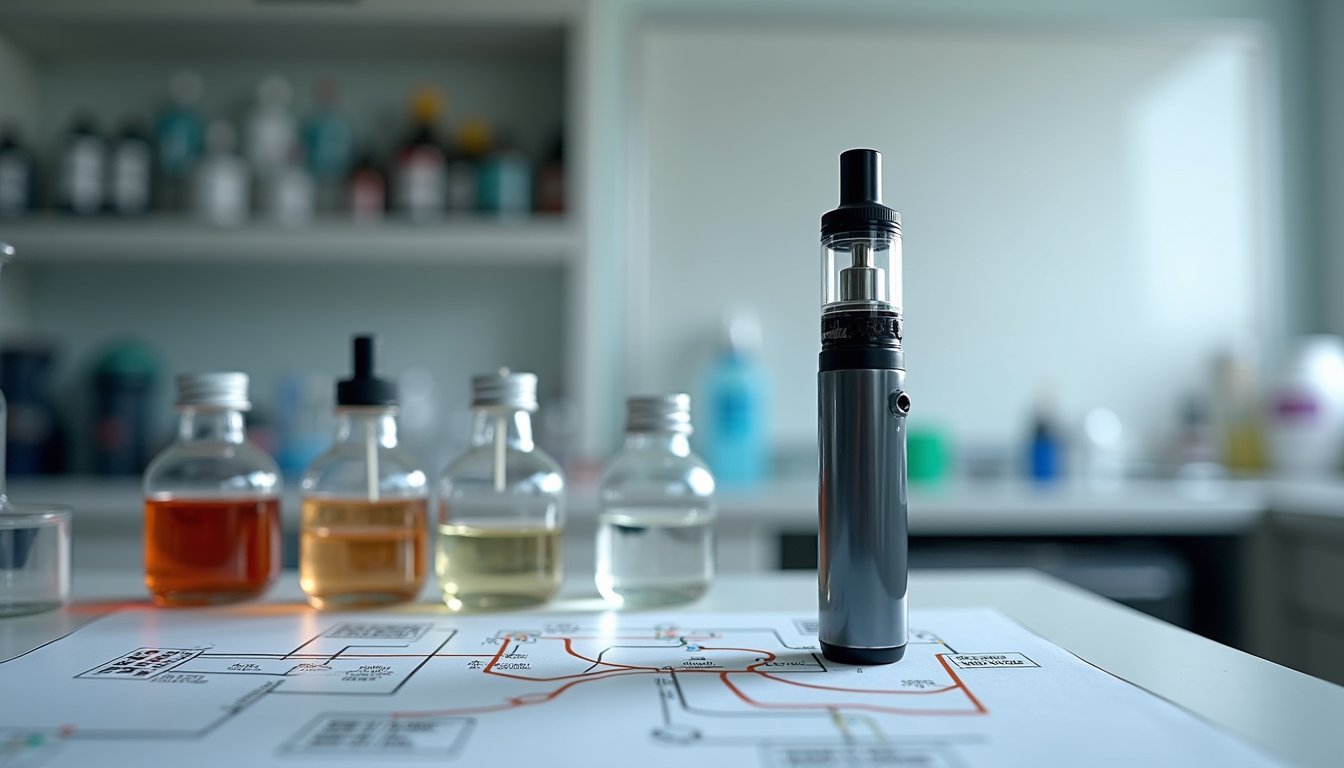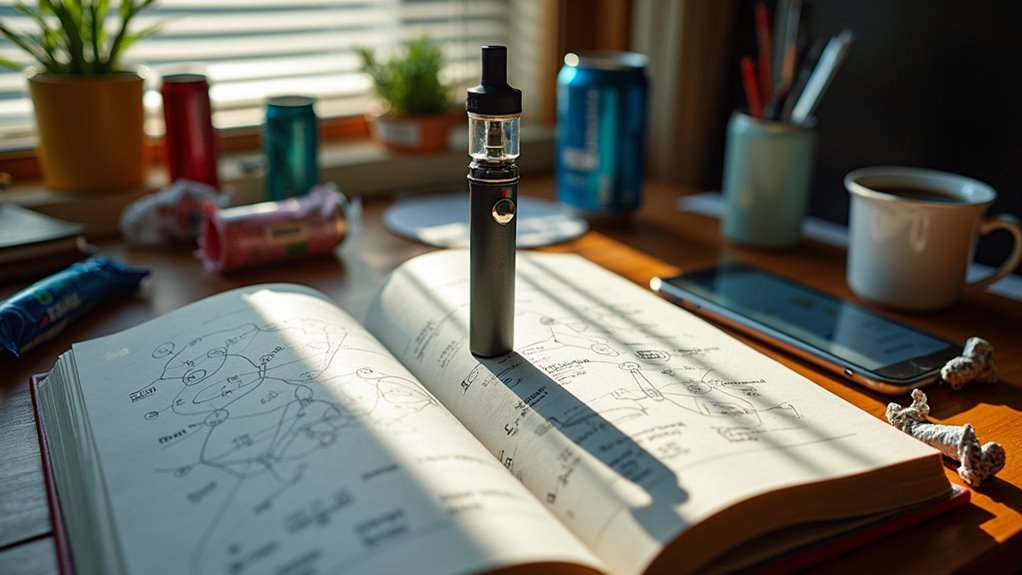When you vape, your brain’s chemistry rapidly transforms. The e-liquid’s nicotine molecules cross your blood-brain barrier within 7-10 seconds, targeting α4β2 receptors in your ventral tegmental area. This triggers a 2-10x surge in dopamine, flooding your nucleus accumbens and amygdala. Your hippocampus forms powerful memory associations with this artificial pleasure rush, creating a 32% chance of dependency. The complex interplay between molecular structure and neural pathways reveals an intricate chemical cascade.
The Basic Chemistry Behind E-Liquid Formulation

The formulation of e-liquid relies on a precise balance of four core components: propylene glycol (PG), vegetable glycerin (VG), nicotine, and flavoring compounds. You’ll find PG and VG working in synergy, with PG acting as a thin carrier for flavors while VG produces dense vapor clouds. Common ratios range from 50:50 to 70:30 PG/VG. Many users prefer VG-heavy mixtures for generating larger vapor clouds during inhalation. Nicotine poisoning can result from exposure to high concentrations through inhalation or ingestion.
Understanding flavor agent toxicity profiles is indispensable, as compounds like vanillin and furaneol carry specific hazard identifiers. A typical e-liquid contains an average of ten flavoring ingredients. Ingredient manufacturing consistency directly impacts safety, with poor production potentially introducing contaminants like heavy metals.
When heated above 180°C, PG breaks down into aldehydes and acids, while VG shows better chemical stability. The mixture’s final composition affects both its vaporization characteristics and potential health implications, particularly when nicotine concentrations vary from 0 to 100mg/mL.
Understanding Nicotine’s Molecular Structure
Nicotine’s molecular architecture centers on a unique dual-ring system, comprising pyridine and pyrrolidine heterocycles linked by methyl groups, with a molecular formula of C₁₀H₁₄N₂. This structure’s molecular stereochemistry plays an indispensable role in its biological activity, with the (S)-nicotine enantiomer demonstrating superior binding affinity to α4β2 nicotinic receptors compared to its (R) counterpart. The compound’s natural defense mechanism helps protect tobacco plants from insect herbivores.
You’ll find the molecule’s reactive sites, particularly the nitrogen atoms in both rings, enable essential hydrogen bonding and receptor interactions. These enantiomeric effects directly impact nicotine’s pharmacological properties, as the naturally occurring (S)-form exhibits amplified biological activity. The compound’s toxic nature makes it fatal if swallowed and requires careful handling during research and manufacturing. When you examine nicotine’s structure in e-liquid formulations, you’ll notice it maintains its molecular integrity during vaporization, preserving its bioavailability and addiction potential. The compound exists as a hygroscopic, oily liquid that readily dissolves in both alcohol and ether solvents.
From Liquid to Vapor: The Physics of Aerosolization

During vaporization, e-liquid undergoes a complex phase shift governed by precise thermodynamic principles and electrical interactions. The process begins when cotton wicks absorb e-liquid, delivering it to a heating coil that operates between 100-250°C. When activated by the user, the switch button initiates this precise heating sequence. You’ll find consistent vaporization performance relies on the power equation P = V²/R, where voltage and resistance determine heat generation. The residual heat energy from this process can accumulate in the atomizer walls during frequent puffing. The vegetable glycerin and propylene glycol mixture serves as the base liquid that enables proper vaporization at lower temperatures.
Airflow design impacts both vapor density and cooling effectiveness. As e-liquid heats, it transforms into an aerosol that’s predominantly liquid particles rather than true vapor. The composition varies based on your PG/VG ratio PG vaporizes at 188°C creating thinner clouds, while VG requires 290°C for denser output. Strategic placement of coils near wicks, combined with adjustable airflow restrictors, certifies efficient heat transfer and ideal particle formation during inhalation.
Brain Chemistry Changes During First-Time Use
When you inhale vaporized nicotine for the initial time, your brain’s reward circuitry activates within seconds as dopamine floods the nucleus accumbens and ventral tegmental area. Your mesolimbic pathway immediately establishes connections between the nicotine consumption and pleasure signals, while epinephrine and beta-endorphin release amplifies the rewarding sensation. Common flavoring agents like menthol and farnesol enhance this reward-related behavior by increasing nicotine’s bioavailability and potentiating its effects on dopaminergic neurons. For first-time users, there is approximately a 32 percent chance of developing nicotine dependence.
This rapid neurochemical cascade triggers both immediate reinforcement of nicotine-seeking behavior and initiates long-term changes in receptor sensitivity, setting the foundation for potential addiction. The process is particularly concerning since developing brains are more susceptible to these neurological changes during adolescence and young adulthood.
Rapid Dopamine Response Begins
The initial hit from a vaping device sets off a cascade of rapid neurochemical changes, crossing the blood-brain barrier within 7-10 seconds. When nicotine reaches your brain, it immediately targets α4β2 receptors in the ventral tegmental area, triggering a surge of dopamine 2-10 times above your baseline levels.
Your brain’s dopamine signaling thresholds rapidly adjust as the chemical floods three key regions: the nucleus accumbens, amygdala, and hippocampus. This activation creates an artificial amplification to your natural stress relief mechanisms, delivering an instant rush of pleasure and emotional satisfaction. Nearly 70 percent of smokers express a desire to quit once they become dependent on nicotine. These pleasure signals are actually short-term effects that mask the underlying stress nicotine creates.
The process simultaneously forms powerful memory associations, as your hippocampus records this new experience as highly rewarding. Your brain quickly begins linking the physical act of vaping with this intense dopamine release, laying the groundwork for addictive patterns.
Neurotransmitter Pathways Activate Fast
Inside your brain, nicotine’s initial contact with α4β2 receptors initiates a complex cascade of neurotransmitter interactions that reshape neural signaling within seconds. Nicotine induced neural plasticity begins as acetylcholine receptor dysfunction disrupts normal signaling patterns.
| Neurotransmitter | Immediate Effect |
|---|---|
| Dopamine | Rapid surge in NAC and VTA |
| GABA | Decreased inhibitory control |
| Serotonin | Reduced mood regulation |
You’ll experience these changes almost instantly as your brain’s chemistry shifts. The prefrontal cortex shows immediate hyperexcitability while the amygdala and hippocampus undergo rapid modulation. Your brain’s reward pathways activate strongly, particularly if you’re under 25, when neural plasticity is heightened. These rapid-fire changes create the foundation for potential dependency, as your brain’s neurotransmitter systems adapt to nicotine’s presence.
Brain Reward Centers Transform
Through nicotine’s initial binding to α4β2 receptors, your brain undergoes rapid structural and functional transformations within seconds of inaugural use. Your ventral tegmental area neurons hyperactivate while dopamine floods your nucleus accumbens, triggering immediate structural adaptations in critical brain regions.
Your reward circuitry experiences profound functional dysregulation as nicotine penetrates your blood-brain barrier, causing inflammation and altered synaptic plasticity. You’ll notice changes in your prefrontal cortex connectivity, impacting decision-making capabilities, while your hippocampus undergoes modifications affecting memory formation. Your mesolimbic system becomes hypersensitive to nicotine-related cues, fundamentally rewiring your brain’s reward processing.
These neurological changes persist, reducing your baseline dopamine levels and diminishing your response to non-nicotine rewards, creating a biological foundation for long-term dependency.
Dopamine’s Role in Creating Reward Pathways
When nicotine enters your bloodstream through vaping, it rapidly crosses the blood-brain barrier and triggers a cascade of neurochemical events centered around dopamine release. The process begins as nicotine molecules bind to specialized acetylcholine receptors, initiating dopaminergic reinforcement throughout the brain’s reward centers.
Your brain’s mesolimbic pathway remodeling occurs within seconds, as nicotine activates voltage-gated calcium channels in dopamine-producing neurons. This triggers the release of dopamine-filled vesicles into synaptic spaces, creating an intense pleasure signal. The rapid surge of dopamine reinforces the behavior, while repeated exposure increases the density of nicotine receptors in reward pathways. The environmental cues and triggers associated with vaping can intensify these cravings and make quitting more difficult.
You’ll need increasingly higher doses to achieve satisfaction as your brain adapts to this artificial stimulation, establishing a cycle of dependence that hijacks natural reward mechanisms.
Chemical Triggers for Environmental Cues

Your brain’s olfactory system responds instantly to vaping-related scents through GABAergic and glutamatergic pathways, creating powerful neurochemical signals that trigger cravings.
The auditory processing of vape device sounds activates your limbic system’s emotional circuits, reinforcing established addiction pathways through neurotransmitter release.
These sensory triggers work synergistically in your brain, amplifying each other’s effects and strengthening the neurochemical responses that drive compulsive vaping behavior.
Scent-Activated Brain Pathways
Three distinct chemical mechanisms drive scent-activated brain pathways in vaping addiction. Initial, through molecular mimicry, nicotine binds to acetylcholine receptors while scent molecules activate these same pathways, triggering dopamine release. You’ll experience heightened sensitivity as repeated exposure upregulates these receptors.
Second, your brain forms learned scent associations through Pavlovian conditioning, creating powerful memory traces between specific flavors and nicotine’s pleasurable effects. These associations predict relapse risk and drive compulsive behavior when you encounter familiar vaping scents.
Finally, synthetic flavor compounds in e-liquids directly interact with your olfactory receptors, potentially cross-reacting with nicotinic pathways. This bypasses your prefrontal cortex’s rational control, stimulating reward centers and amplifying dopamine release – particularly during adolescence when your brain is most vulnerable to addiction formation.
Device Sounds Trigger Cravings
Beyond scent-activated pathways, device-generated sounds create powerful neurochemical responses that reinforce vaping addiction. Your brain’s reward circuitry responds to these auditory triggers through multisensory conditioning strategies, releasing dopamine and norepinephrine that intensify cravings.
Modern vaping devices exploit this neurochemistry through:
- Clicks and chimes that pair with nicotine delivery
- Gamified sound elements triggering dopamine release
- Low-battery alerts exploiting maintenance-related cognitive bias
- Vibration-sound combinations creating compound craving triggers
You’ll find these auditory cues particularly potent during withdrawal, as your brain’s chemistry drives you to seek relief. While cognitive bias reduction techniques can help combat these triggers, the sophisticated interplay between device sounds and neurological responses makes breaking the addiction cycle especially challenging without targeted intervention strategies.
The Science of Tolerance Development
Multiple biological mechanisms drive nicotine tolerance development, starting with rapid adaptations in nicotinic acetylcholine receptors (nAChRs) throughout the central nervous system. Your brain responds to repeated nicotine exposure by upregulating these receptors while simultaneously desensitizing their responses, requiring higher doses to achieve the same effects.
Your genetic susceptibility factors, particularly mutations in the CHRNA5 gene, influence how quickly you’ll develop tolerance. Metabolic enzyme variations, especially in the CYP450 family, determine your nicotine metabolism rate and subsequent adaptation patterns. If you’re a slow metabolizer, you’ll experience prolonged CNS effects and face higher dependence risks. This complex interplay between receptor adaptation, genetic predisposition, and metabolic factors creates a personalized trajectory of tolerance development that can accelerate your path to nicotine dependence.
Molecular Mechanisms of Withdrawal
When you stop vaping, your brain’s carefully balanced neurotransmitter systems experience significant disruption, particularly in nicotinic acetylcholine receptors (nAChRs) and dopamine pathways.
Your withdrawal symptoms manifest through the medial habenula-interpeduncular pathway, where α3β4* and α5 receptor subunits trigger physical distress patterns like tremors and increased grooming behaviors.
The severity of your withdrawal correlates directly with the degree of α4β2* receptor upregulation in your brain’s reward centers, explaining why long-term vapers often face more intense withdrawal experiences.
Neurotransmitter Imbalance Effects
Three major neurotransmitter systems drive the molecular mechanisms of vaping withdrawal: dopamine, GABA, and acetylcholine. When you vape, nicotine triggers complex cascading effects that create long term GABAergic imbalance and nicotine dependent neuroplasticity changes in your brain’s reward circuitry.
During withdrawal, you’ll experience disruptions across multiple systems:
- Depleted dopamine levels reduce your ability to feel pleasure from natural rewards
- Suppressed GABA activity increases anxiety and impairs impulse control
- Desensitized acetylcholine receptors require higher nicotine doses for effect
- Altered synaptic connections in the VTA-NAc pathway maintain cravings
These neurochemical imbalances explain why you might struggle with mood regulation, cognitive function, and stress management during withdrawal, often persisting weeks beyond the initial physical symptoms.
Physical Distress Patterns
Physical distress during nicotine withdrawal stems from complex molecular cascades involving specific nicotinic acetylcholine receptor (nAChR) subtypes. You’ll experience somatic withdrawal symptoms like tremors and nausea primarily through α5/β4 subunit activation in the MHb-IPN pathway. These physical manifestations intensify when genetic vulnerability factors, particularly variants in the CHRNA5-CHRNA3-CHRNB4 locus, are present.
Your brain’s adaptation to nicotine creates a distinctive pattern where α3β4* receptors become increasingly sensitive during withdrawal, while α4β2* receptors maintain stability. This molecular imbalance triggers withdrawal-induced stress responses, activating specific nAChR subunits that worsen your physical distress. The severity peaks within days but can persist longer, especially if you’ve undergone multiple withdrawal cycles, which progressively alter receptor dynamics in your striatum and hippocampus.
Heat-Induced Chemical Transformations
The complex chemistry of vaping centers on heat-induced transformations that occur when e-liquids reach vaporization temperatures. These chemical reactions create toxic byproducts through multiple pathways, with carbonyl emissions increasing as temperatures rise and metal catalysis accelerating decomposition.
Vaping’s dangerous chemistry emerges when heat transforms e-liquids, creating toxic compounds through rising temperatures and metal-catalyzed breakdown reactions.
The primary chemical transformations follow this sequence:
- Propylene glycol undergoes thermal oxidation, generating formaldehyde and acetaldehyde
- Vegetable glycerin dehydrates, producing increasing levels of acrolein
- Metal heating coils catalyze additional breakdown reactions at lower temperatures
- Phase shifts occur as PG depletes faster than VG, shifting the aerosol composition
Your exposure to these compounds varies based on device settings and puffing behavior. Higher temperatures and longer puff durations amplify the formation of harmful chemicals, while metal surfaces can trigger reactions even below standard vaporization points.
Neural Pathway Alterations and Dependency
When nicotine enters your bloodstream through vaping, it triggers a cascade of neurological changes that fundamentally alter brain chemistry and neural architecture. Your brain’s dopamine system rapidly adapts, creating reward pathways that prioritize vaping over natural stimuli, while serotonin disruption impairs your emotional control mechanisms.
You’ll experience significant cognitive impairment severity as acetylcholine receptor density increases, leading to intensified cravings and disrupted synaptic efficiency. This neural reconfiguration particularly affects your prefrontal cortex, resulting in academic performance disruption through compromised attention, memory, and decision-making abilities.
Your brain’s plasticity makes you especially vulnerable during adolescence, when nicotine exposure can permanently alter synaptic development and executive function. These changes create a self-reinforcing cycle of dependency, making cessation increasingly challenging as neural pathways become more deeply entrenched.
Frequently Asked Questions
How Long Does Nicotine Stay Detectable in Blood After Vaping?
After you vape, nicotine’s blood half-life is approximately 2 hours, but you’ll still test positive for 1-3 days. Your liver rapidly metabolizes nicotine into cotinine, its primary metabolite.
While nicotine detection drops quickly, cotinine remains detectable in your blood for up to 10 days. Your metabolic rate, vaping frequency, and e-liquid concentration will affect these timeframes.
Laboratory tests can detect both compounds at levels above 5 ng/mL.
Can Secondhand Vapor Exposure Lead to Nicotine Dependence?
Based on current evidence, you won’t develop nicotine dependence from secondhand vapor exposure. The data shows nicotine absorption rates are 83.6% lower than secondhand smoke, and serum cotinine levels remain below 15 μg/L too low to trigger addiction.
While passive exposure risks include respiratory symptoms and airway irritation, there’s no clinical evidence linking secondhand vapor to dependence. However, social normalization concerns persist regarding increased vapor exposure in public spaces.
Why Do Some People Experience Headaches When They First Start Vaping?
When you initially start vaping, headaches can occur due to two primary mechanisms.
To begin with, your body may experience rapid fluctuations in nicotine levels, triggering withdrawal symptoms between vaping sessions.
Second, the propylene glycol and vegetable glycerin in e-liquids actively draw moisture from your body, leading to dehydration and headaches.
You’ll need to carefully monitor your nicotine intake and increase your water consumption to minimize these effects.
Does Switching Between Different E-Liquid Flavors Affect Addiction Potential?
Your flavor switching habits can impact addiction potential in several ways. When you regularly change flavors, you’re triggering varied brain activation patterns, which may intensify novelty-seeking behaviors.
Your flavor preferences can also lead to increased consumption since diverse tastes help mask nicotine’s harshness. Research suggests that switching between flavors may disrupt consistent craving relief patterns, potentially making you more dependent on vaping to maintain satisfaction levels.
How Does Temperature Control in Vaping Devices Impact Chemical Absorption Rates?
Temperature control markedly affects your vapor composition effects and chemical uptake.
When you vape at higher temperatures (250-356°C), you’ll experience increased absorption rates due to more efficient aerosolization. Temperature variation impacts both degradation patterns and bioavailability higher temps create more complex chemical mixtures, while lower temps (176-200°C) may limit some compound breakdown but still enable oxidation-enhanced absorption, especially with nicotine salts and VEA-containing liquids.










